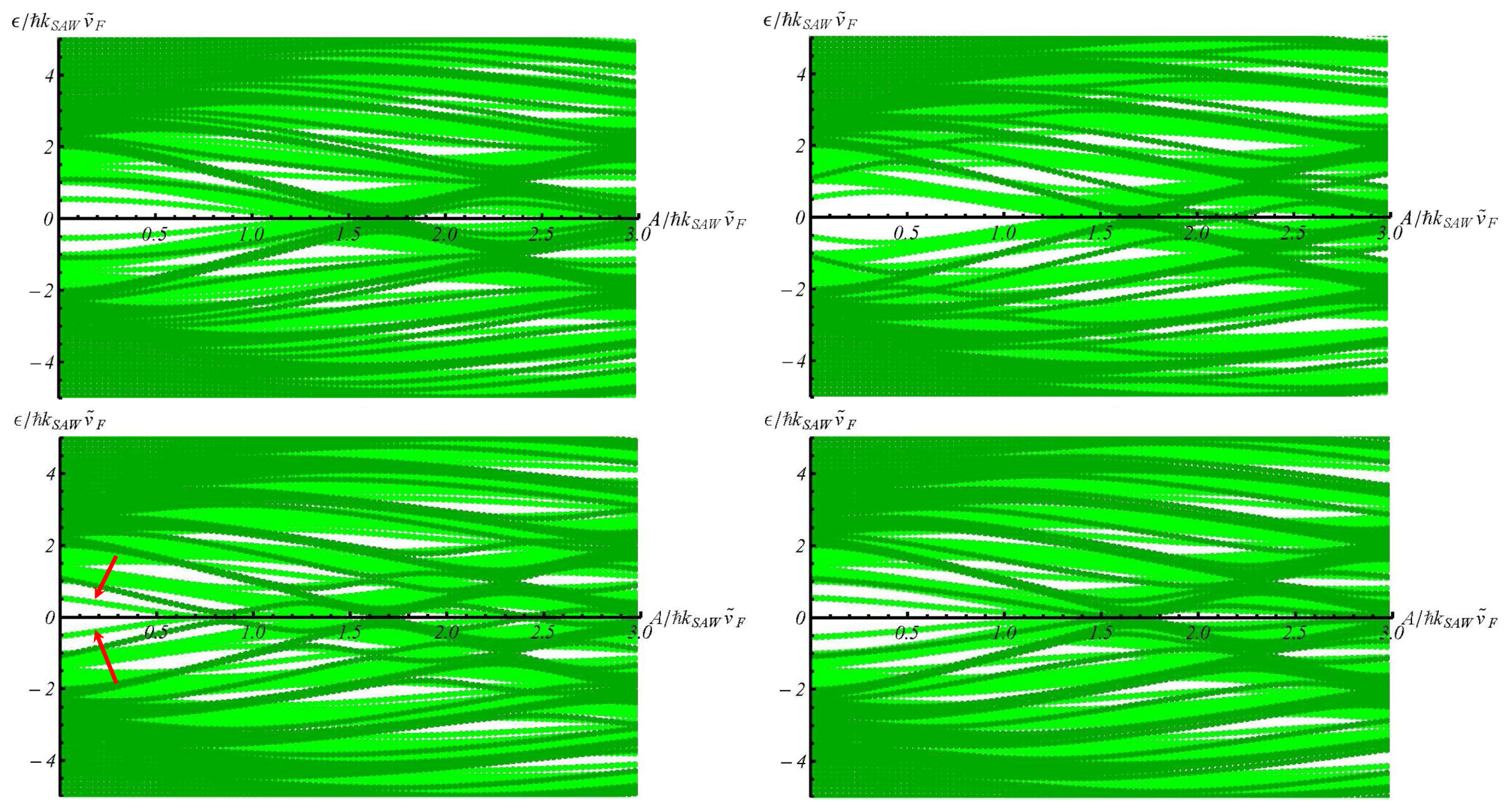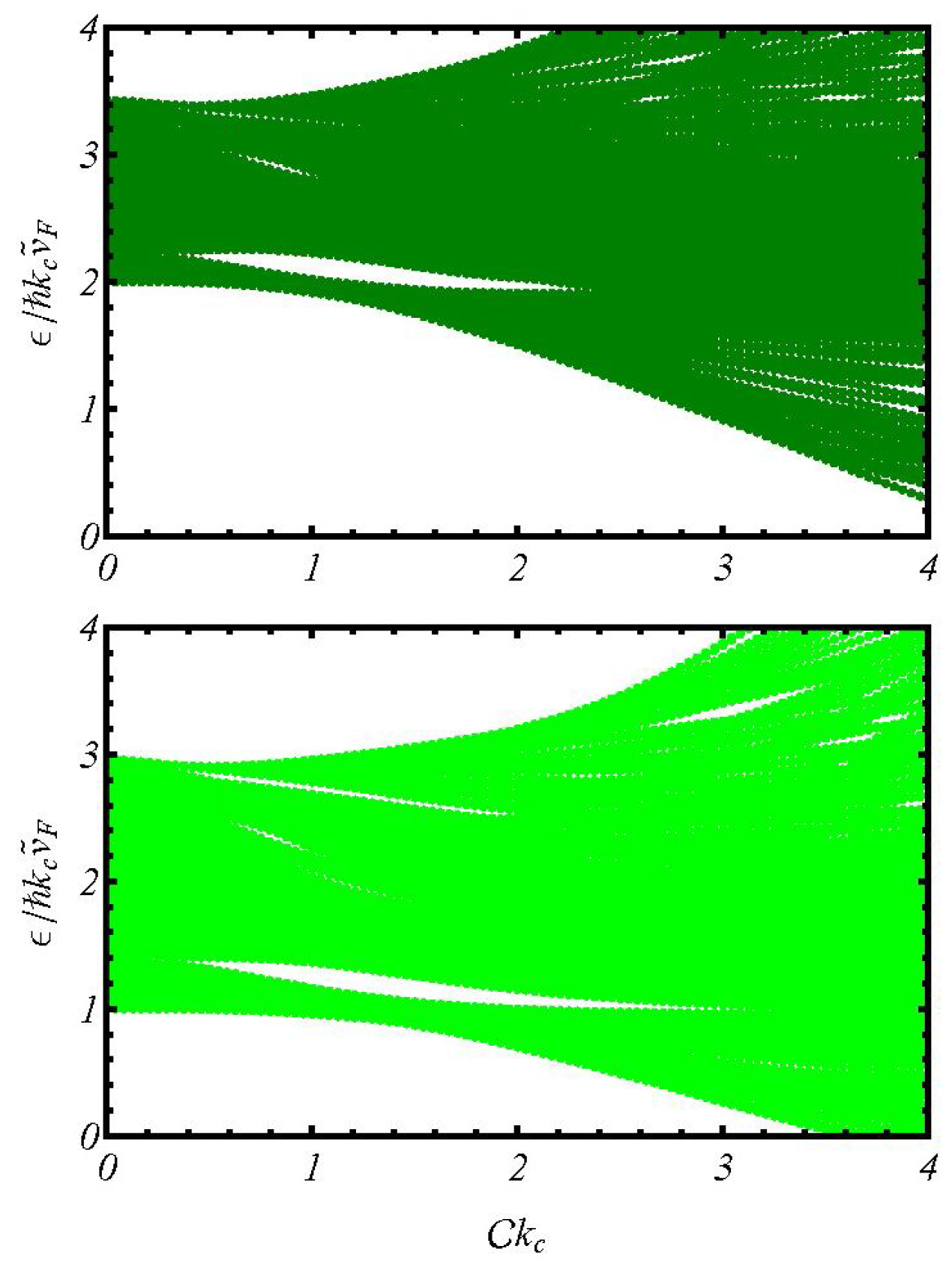Effects of Localized Trap-States and Corrugation on Charge Transport in Graphene Nanoribbons
Abstract
:1. Introduction
2. Miniband Structure with Localized Trap States
3. Numerical Simulation and Discussions



4. Concluding Remarks
Acknowledgements
References
- Talyanskii, V.I.; Novikov, D.S.; Simons, B.D.; Levitov, L.S. Quantized adiabatic charge transport in a carbon nanotube. Phys. Rev. Lett. 2001, 87, 276802. [Google Scholar]
- Kouwenhoven, L.P.; Johnson, A.T.; van der Vaart, N. C.; Harmans, C.J.P.M.; Foxon, C.T. Quantized current in a quantum-dot turnstile using oscillating tunnel barriers. Phys. Rev. Lett. 1991, 67, 1626. [Google Scholar] [PubMed]
- Keller, M.W.; Eichenberger, A.L.; Martinis, J.M.; Zimmerman, N.M. A capacitance standard based on counting electrons. Science 1999, 285, 1706. [Google Scholar] [CrossRef] [PubMed]
- Shilton, J.M.; Talyanskii, V.I.; Pepper, M.; Ritchie, D.A.; Frost, J.E.F.; Ford, C.J.B.; Smith, C.G.; Jones, G.A.C. High-frequency single-electron transport in a quasi-one-dimensional GaAs channel induced by surface acoustic waves. J. Phys. 1996, 8, L531. [Google Scholar] [CrossRef] [PubMed]
- Talyanskii, V.I.; Shilton, J.M.; Pepper, M.; Smith, C.G.; Ford, C.J.B.; Linfield, E.H.; Ritchie, D.A.; Jones, G.A.C. Single-electron transport in a one-dimensional channel by high-frequency surface acoustic waves. Phys. Rev. B 1997, 56, 15180. [Google Scholar] [CrossRef]
- Aǐzin, G.R.; Gumbs, G.; Pepper, M. Screening of the surface-acoustic-wave potential by a metal gate and the quantization of the acoustoelectric current in a narrow channel. Phys. Rev. B 1998, 58, 10589. [Google Scholar] [CrossRef]
- Gumbs, G.; Aǐzin, G.R.; Pepper, M. Coulomb interaction of two electrons in the quantum dot formed by the surface acoustic wave in a narrow channel. Phys. Rev. B 1999, 60, R13954. [Google Scholar] [CrossRef]
- Gumbs, G.; Aǐzin, G.R.; Pepper, M. Interaction of surface acoustic waves with a narrow electron channel in a piezoelectric material. Phys. Rev. B 1998, 57, 1654. [Google Scholar] [CrossRef]
- Blumenthal, M.D.; Kaestner, B.; Li, L.; Giblin, S.; Janssen, T.J.B.M.; Pepper, M.; Anderson, D.; Jones, G.; Ritchie, D.A. Gigahertz quantized charge pumping. Nat. Phys. 2007, 3, 343. [Google Scholar] [CrossRef]
- Kaestner, B.; Kashcheyevs, V.; Amakawa, S.; Blumenthal, M.D.; Li, L.; Janssen, T.J.B.M.; Hein, G.; Pierz, K.; Weimann, T.; Siegner, U.; et al. Single-parameter nonadiabatic quantized charge pumping. Phys. Rev. B 2008, 77, 153301. [Google Scholar] [CrossRef]
- Thouless, D.J. Quantization of particle transport. Phys. Rev. B 1983, 27, 6083. [Google Scholar] [CrossRef]
- Huang, D.H.; Gumbs, G.; Pepper, M. Effects of inelastic capture, tunneling escape, and quantum confinement on surface acoustic wave-dragged photocurrents in quantum wells. J. Appl. Phys. 2008, 103, 083714. [Google Scholar] [CrossRef]
- Robinson, A.M.; Talyanskii, V.I. Shot noise in the current of a surface acoustic-wave-driven single electron pump. Phys. Rev. Lett. 2005, 95, 247202. [Google Scholar] [CrossRef] [PubMed]
- Wright, S.J.; Blumenthal, M.D.; Gumbs, G.; Thorn, A.L.T.; Holmes, S.N.; Janssen, T.J.B.M.; Pepper, M.; Anderson, D.; Jones, G.A.C.; Nicoll, C.N.; et al. Enhanced current quantization in high-frequency electron pumps in a perpendicular magnetic field. Phys. Rev. B 2008, 78, 233311. [Google Scholar] [CrossRef]
- Wright, S.J.; Thorn, A.L.; Blumenthal, M.D.; Giblin, S.P.; Pepper, M.; Janssen, T.J.B.M.; Kataoka, M.; Fletcher, J.D.; Jones, G.A.C.; Nicoll, C.A.; Gumbs, G.; Ritchie, D.A. Single- and few-electron dynamic quantum dots in a perpendicular magnetic field. J. Appl. Phys. 2011, 109, 102422. [Google Scholar] [CrossRef]
- Neto, A.H.C.; Guinea, F.; Peres, N.M.R.; Novoselov, K.S.; Geim, A.K. The electronic properties of graphene. Rev. Mod. Phys. 2009, 81, 109–162. [Google Scholar] [CrossRef]
- Special issue on Electronic and Photonic Properties of Graphene Layers and Carbon Nanoribbons. Gumbs, G.; Huang, D.H.; Roslyak, O. (Eds.) Philos. Trans. R. Soc. Lodon, Ser. A, 2010; 138, No. 1932.
- Abergel, D.S.L.; Apalkov, V.; Berashevich, J.; Ziegler, K.; Chakraborty, T. Properties of graphene: A theoretical perspective. Adv. Phys. 2010, 59, 261–482. [Google Scholar] [CrossRef]
- Orlita, M.; Potemski, M. Dirac electronic states in graphene systems: Optical spectroscopy studies. Semicond. Sci. Technol. 2010, 25, 063001. [Google Scholar] [CrossRef]
- Das Sarma, S.; Adam, S.; Hwang, E.H.; Rossi, E. Electronic transport in two-dimensional graphene. Rev. Mod. Phys. 2011, 83, 407–470. [Google Scholar] [CrossRef]
- Novoselov, K.S.; Geim, A.K.; Morozov, S.V.; Jiang, D.; Katsnelson, M.I.; Grigorieva, I.V.; Dubonos, S.V.; Firsov, A.A. Electric field effect in atomically thin carbon films. Science 2001, 306, 666–669. [Google Scholar] [CrossRef] [PubMed]
- Novoselov, K.S.; Geim, A.K.; Morozov, S.V.; Jiang, D.; Katsnelson, M.I.; Grigorieva, I.V.; Dubonos, S.V.; Firsov, A.A. Two-dimensional gas of massless Dirac fermions in graphene. Nature 2005, 438, 197–200. [Google Scholar] [CrossRef] [PubMed] [Green Version]
- Zhang, Y.; Tan, Y.-W.; Störmer, H.L.; Kim, P. Experimental observation of the quantum Hall effect and Berry’s phase in graphene. Nature 2005, 438, 201–204. [Google Scholar] [CrossRef] [PubMed]
- Katsnelson, M.I.; Novoselov, K.S.; Geim, A.K. Chiral tunnelling and the Klein paradox in graphene. Nat. Phys. 2006, 2, 620–625. [Google Scholar] [CrossRef] [Green Version]
- Young, A.F.; Kim, P. Quantum interference and Klein tunnelling in graphene. Nat. Phys. 2009, 5, 222–226. [Google Scholar] [CrossRef]
- Roslyak, O.; Iurov, A.; Gumbs, G.; Huang, D.H. Unimpeded tunneling in graphene nanoribbons. J. Phys. 2010, 22, 165301. [Google Scholar] [CrossRef] [PubMed]
- Iurov, A.; Gumbs, G.; Roslyak, O.; Huang, O.H. Anomalous photon-assisted tunneling in graphene. J. Phys. 2012, 24, 015303. [Google Scholar] [CrossRef] [PubMed]
- Wunsch, B.; Stauber, T.; Sols, F.; Guinea, F. Dynamical polarization of graphene at finite doping. New J. Phys. 2006, 8, 318. [Google Scholar] [CrossRef]
- Wang, E.H.; Das Sarma, S. Dielectric function, screening, and plasmons in two-dimensional graphene. Phys. Rev. B 2007, 75, 205418. [Google Scholar] [CrossRef]
- Roslyak, O.; Gumbs, G.; Huang, D.H. Plasma excitations of dressed Dirac electrons in graphene layers. J. Appl. Phys. 2011, 109, 113721. [Google Scholar] [CrossRef]
- Mak, K.F.; Sfeir, M.Y.; Wu, Y.; Lui, C.H.; Misewich, J.A.; Heinz, T.F. Measurement of the optical conductivity of graphene. Phys. Rev. Lett. 2008, 101, 196405. [Google Scholar] [CrossRef] [PubMed]
- Nair, R.R.; Blake, P.; Grigorenko, A.N.; Novoselov, K.S.; Booth, T.J.; Stauber, T.; Peres, N.M.R.; Geim, A.K. Fine structure constant defines visual transparency of graphene. Science 2008, 320, 1308. [Google Scholar] [CrossRef] [PubMed]
- Ju, L.; Geng, B.; Horng, J.; Girit, C.; Martin, M.; Hao, Z.; Bechtel, H.A.; Liang, H.A.; Zettl, A.; Shen, Y.R.; et al. Graphene plasmonics for tunable terahertz metamaterials. Nat. Nanotechnol. 2011, 6, 630–634. [Google Scholar] [CrossRef] [PubMed]
- Huang, D.H.; Gumbs, G.; Roslyak, O. Effects of nonlocal plasmons in coupled gapped graphene micro-ribbon array and two-diemnsional electron gas on near-field electromagnetic response in the deep-subwavelength regime. Appl. Opt. 2013, 52, 755–769. [Google Scholar] [CrossRef] [PubMed]
- Li, Z.Q.; Henriksen, E.A.; Jiang, Z.; Hao, Z.; Martin, M.C.; Kim, P.; Störmer, H.L.; Basov, D.N. Dirac charge dynamics in graphene by infrared spectroscopy. Nat. Phys. 2008, 4, 532–535. [Google Scholar] [CrossRef]
- Wang, F.; Zhang, Y.; Tian, C.; Girit, C.; Zettl, A.; Crommie, M.; Shen, Y.R. Gate-variable optical transitions in graphene. Science 2008, 320, 206–209. [Google Scholar] [CrossRef]
- Bao, Q.; Zhang, H.; Wang, B.; Ni, Z.; Haley, C.; Lim, Y.X.; Wang, Y.; Tang, D.Y.; Loh, K.P. Broadband graphene polarizer. Nat. Photonics 2011, 5, 411–415. [Google Scholar] [CrossRef]
- Strait, J.H.; Wang, H.; Shivaraman, S.; Shields, V.; Spencer, M.; Rana, F. Hot carrier transport and photocurrent response in graphene. Nano Lett. 2011, 11, 4688–4692. [Google Scholar]
- Song, J.C.W.; Rudner, M.S.; Marcus, C.M.; Levitov, L.S. Very slow cooling dynamics of photoexcited carriers in graphene observed by optical-pump terahertz-probe spectroscopy. Nano Lett. 2011, 11, 4902–4906. [Google Scholar]
- Roslyak, O.; Gumbs, G.; Huang, D.H. Tunable band structure effects on ballistic transport in graphene nanoribbons. Phys. Lett. A 2010, 374, 4061–4064. [Google Scholar]
- Huang, D.H.; Gumbs, G.; Roslyak, O. Field enhanced mobility by nonlinear phonon scattering of Dirac electrons in semiconducting graphene nanoribbons. Phys. Rev. B 2011, 83, 115405. [Google Scholar]
- Roslyak, O.; Gumbs, G.; Huang, D.H. Energy loss spectroscopy of epitaxial versus free-standing multilayer graphene. Phys. E 2012, 44, 1874–1884. [Google Scholar]
- Cox, J.D.; Singh, M.R.; Gumbs, G.; Anton, M.A.; Carreno, F. Dipole-dipole interaction between a quantum dot and a graphene nanodisk. Phys. Rev. B 2012, 86, 125452. [Google Scholar] [CrossRef]
- Cunningham, J.; Talyanskii, V.I.; Shilton, J.M.; Pepper, M. Single-electron acoustic charge transport on shallow-etched channels in a perpendicular magnetic field. Phys. Rev. B 2000, 62, 1564. [Google Scholar] [CrossRef]
- Atanasov, V.; Saxena, A. Tuning the electronic properties of corrugated graphene: Confinement, curvature, and band-gap opening. Phys. Rev. B 2010, 81, 205409. [Google Scholar] [CrossRef]
A. Energy Band Calculations in Absence of Electron Traps
A.1. Carbon Nanotubes
A.2. Graphene Nanoribbons
A.3. Corrugated Nanoribbons
© 2013 by the authors. Licensee MDPI, Basel, Switzerland. This article is an open access article distributed under the terms and conditions of the Creative Commons Attribution license ( http://creativecommons.org/licenses/by/3.0/).
Share and Cite
Roslyak, O.; Aparajita, U.; Gumbs, G.; Huang, D. Effects of Localized Trap-States and Corrugation on Charge Transport in Graphene Nanoribbons. Electronics 2013, 2, 178-191. https://doi.org/10.3390/electronics2020178
Roslyak O, Aparajita U, Gumbs G, Huang D. Effects of Localized Trap-States and Corrugation on Charge Transport in Graphene Nanoribbons. Electronics. 2013; 2(2):178-191. https://doi.org/10.3390/electronics2020178
Chicago/Turabian StyleRoslyak, Oleksiy, Upali Aparajita, Godfrey Gumbs, and Danhong Huang. 2013. "Effects of Localized Trap-States and Corrugation on Charge Transport in Graphene Nanoribbons" Electronics 2, no. 2: 178-191. https://doi.org/10.3390/electronics2020178
APA StyleRoslyak, O., Aparajita, U., Gumbs, G., & Huang, D. (2013). Effects of Localized Trap-States and Corrugation on Charge Transport in Graphene Nanoribbons. Electronics, 2(2), 178-191. https://doi.org/10.3390/electronics2020178



